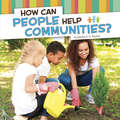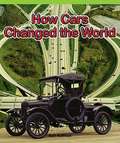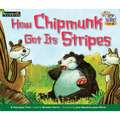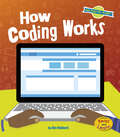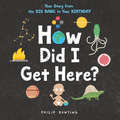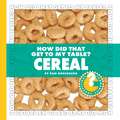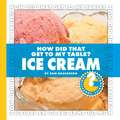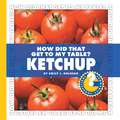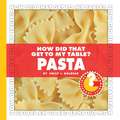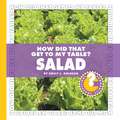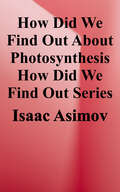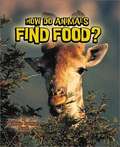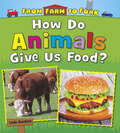- Table View
- List View
How Bodies Work: Animal Physiology
by Bridget AndersonDo you ever wonder what makes you grow? Or why you shiver when you are cold? Have you ever marveled at the speed of a cheetah, the fastest land animal on Earth? Or been awed at how a chameleon can change color? Solving such mysteries is part and parcel of animal physiology, the science that investigates how different animal bodies work. Learning how they do increases our appreciation of the uniqueness and diversity of the vast animal kingdom, and adds to our understanding of how our own bodies work. HOW BODIES WORK: ANIMAL PHYSIOLOGY offers a glimpse inside ourselves and the amazing world around us.
How Butterflies Came to Be [On Level, Grade 2]
by Deborah November Gina CapaldiNIMAC-sourced textbook
How Can People Help Communities? (Community Questions)
by Martha E. RustadA community is only as strong as its individual members. What roles do those members play, and how do citizens work together to complete common tasks and achieve goals? A clear question-answer format, paired with photos kids can relate to, shows the importance of responsibility and cooperation. A simple activity encourages young readers to actively participate in their own community.
How Carrot and Cookie Saved Christmas
by Erica S. PerlA festive pun-filled story perfect for the holidays!In this follow-up to When Carrot Met Cookie, Christmas is fast approaching, and Carrot and Cookie are both worried—they can't find the right present for each other! But when they hear a crash on Christmas Eve and find a sick Santa too ill to keep flying his sleigh, they know there are more important matters at hand. Can these friends conjure up enough Christmas magic to step into Santa's shoes, deliver the presents themselves, and save the day? Hilarious and heartwarming, this is the perfect gift for future foodies or anyone looking for some special holiday cheer.
How Cars Changed The World
by Kurt HoffmanBright, full-color and black and white historic photographs compare and contrast the cars, roads, and travel experiences of today with those of days gone by. Strongly correlated to the Common Core Standards for Informational Text, this title is perfect for exploring the relationships between a series of historical events and scientific ideas.
How Chipmunk Got Its Stripes: A Pourquoi Tale
by Laura Strom Juan Bautista Juan Oliver Brooke HarrisDo you know why all chipmunks have three stripes down their backs? This pourquoi tale gives a creative explanation as to how this happened. This tale originated with the Seneca Indians.
How Coding Works (Our Digital Planet Ser.)
by Ben HubbardThis book takes the mystery out of computer programming. Learn about coding, algorithms and more.
How Computers Work (Our Digital Planet Ser.)
by Ben HubbardEver wonder what goes on inside your computer? Take a look into how processors, networks, and more are all connected.
How Could a Bear Sleep Here?
by Julie GonzalezIt's time for Shelby to hibernate, but how could a bear sleep in this noisy forest?The woodpeckers are rat-tat-tatting, the squirrels are cracka-cracka-crunching--there's too much noise! When Shelby spies the perfect cave, only too late does he realize he's hopped aboard a tour bus bound for the beach.Coupled with hysterically expressive illustrations by Stephanie Laberis, Julie Gonzalez's lively text and familiar refrain sings as Shelby, after several attempts to snooze in the tropics with increasing exhaustion, finally discovers the perfect solution to his noise problem. This is a great read-aloud for young readers who will recognize the refrain ("How could a bear sleep here?") and the silliness of Shelby's predicament
How Davy Crockett Moved the Sun: An American Tall Tale
by Carol Pugliano-Martin Jeffrey Fuerst Dewayne WhitesidePerform this American tall tale about how Davy Crockett moved the sun.
How Deep Is Your Love: A Children's Picture Book
by Bee GeesA majestic picture book based on the Bee Gees's classic love song "How deep is your love? I really mean to learn 'Cause we're living in a world of fools Breaking us down When they all should let us be We belong to you and me . . ." How Deep Is Your Love is a fantastical picture book based on one of the Bee Gees's biggest hits. The song topped the Billboard Hot 100 chart, remaining in the top ten for seventeen weeks, and won the band's first of eight GRAMMY awards. With lyrics by the Bee Gees and illustrations by J.L. Meyer, the picture book tells the tale of two bunny mermaids who meet on a rock and descend into the water together. As the bunnies escape traps, skirt around nets and hooks, and protect each other in this thrilling adventure, they realize how deep their love is. Meyer's imaginative story compliments the hit song perfectly and will delight children and adults alike.
How Deep Is the Ocean? (Let's-Read-and-Find-Out Science 2)
by Kathleen Weidner ZoehfeldRead and find out about the deepest part of the ocean in this colorfully illustrated nonfiction picture book.The ocean covers almost three-quarters of the Earth, but how deep does it go? Put on your scuba gear and explore the ocean, from its shallowest waters to its deepest, most mysterious parts. As you dive deeper, you’ll discover glowing animals, strange creatures that don’t need sunlight to survive, and even the largest hunter in the world.With beautiful illustrations and engaging text, How Deep Is the Ocean? will guide young readers into the deepest parts of the ocean. Featuring a find-out-more section with a water-pressure experiment, a lesson in making a sounding line to learn how scientists measure the depth of the ocean, a glossary of new terms, and web research prompts, this book will begin children’s explorations of the deep sea. Both the text and the artwork were vetted for accuracy by Dr. David Gruber, real-life deep sea explorer and professor of biology and environmental science at Baruch College.This is a clear and appealing science book for early elementary age kids, both at home and in the classroom. It's a Level 2 Let's-Read-and-Find-Out, which means the book explores more challenging concepts for children in the primary grades. The 100+ titles in this leading nonfiction series are:hands-on and visualacclaimed and trustedgreat for classroomsTop 10 reasons to love LRFOs:Entertain and educate at the same timeHave appealing, child-centered topicsDevelopmentally appropriate for emerging readersFocused; answering questions instead of using survey approachEmploy engaging picture book quality illustrationsUse simple charts and graphics to improve visual literacy skillsFeature hands-on activities to engage young scientistsMeet national science education standardsWritten/illustrated by award-winning authors/illustrators & vetted by an expert in the fieldOver 130 titles in print, meeting a wide range of kids' scientific interestsBooks in this series support the Common Core Learning Standards, Next Generation Science Standards, and the Science, Technology, Engineering, and Math (STEM) standards. Let's-Read-and-Find-Out is the winner of the American Association for the Advancement of Science/Subaru Science Books & Films Prize for Outstanding Science Series.
How Did Humans Go Extinct?
by Paul Hoppe Johnny MarcianoLet’s learn about the most mystifying species to ever walk the Earth!“A clever . . . way to bring awareness to the very real threats to humanity posed by war, climate change, and capitalism. A compelling and unique dystopian sci-fi picture book for early school age readers, this is recommended for all collections.” —School Library JournalPlib is like every other Nøørfbløøk kid on Earth, except for one thing.He loves humans—those horrible, terrifying monsters who dominated the planet ten million years ago.Only one thing about the humans bothers Plib. What happened to them all? Did they turn the planet into an uninhabitable wasteland? Or did they turn on each other? Or did the humans die out because of something else they did—or didn’t—do?Find the answer in How Did Humans Go Extinct?
How Did I Get Here?: Your Story from the Big Bang to Your Birthday
by Philip BuntingFrom the Big Bang to your birthday, and (almost) everything in between, this funny and informative book tells your story.You are one of the newest members of a family tree that goes way, way, way back to the very first life on Earth. A lot of incredible things had to happen between the beginning of the universe and today in order to make you. The fact that you (and everyone you know) are here is nothing short of mind-boggling! Read this book to discover how it happened, and prepare to be amazed by the awesomeness of you.This clever, funny, and scientific timeline of the journey of human existence is designed to get young readers asking questions, finding answers, and marveling at the many wonders of our world, from the Big Bang, to evolution, to a brand-new baby, and more.
How Did That Get in My Lunchbox? The Story of Food
by Chris ButterworthFresh retro artwork lures little readers on a tasty trip to farms, dairies, and more. Yum! The best part of a young child's day is often opening a lunchbox and diving in. But how did all that delicious food get there? Who made the bread for the sandwich? What about the cheese inside? Who plucked the fruit? And where did the chocolate in that cookie get its start? From planting wheat to mixing flour into dough, climbing trees to machine-squeezing fruit, picking cocoa pods to stirring a vat of melted bliss, here is a clear, engaging look at the steps involved in producing some common foods. Healthy tips and a peek at basic food groups complete the menu.
How Did That Get to My Table? Cereal (Community Connections)
by Pam RosenbergYoung readers will gain a better understanding on how the breakfast cereal they love ends up on their breakfast table.
How Did That Get to My Table? Ice Cream (Community Connections)
by Pam RosenbergDo you eat food? Do you use electricity? Do you live in a building or go to a school? These are just some of the activities that connect you to other people in your community. Discover the Community Connections we depend on to provide the things we need. Read the How Did That Get to My Table? books to learn about the connections that bring us our food: Cereal, Ice Cream, Ketchup, Orange Juice, Pasta, Peanut Butter, Pumpkin Pie, Salad. Picture descriptions and captions included.
How Did That Get to My Table? Ketchup (Community Connections)
by Emily J. DolbearWith this title, young readers will gain an understanding on how the ketchup they love, is made and how it ends up on their table. Picture captions and descriptions present.
How Did That Get to My Table? Pasta (Community Connections)
by Emily J. DolbearWith this title, young readers will gain an understanding on how the pasta they love, is made and how it ends up on their table. Picture descriptions and captions included.
How Did That Get to My Table? Peanut Butter (Community Connections)
by Pam RosenbergCOMMUNITY CONNECTIONS--HOW DID THAT GET TO MY TABLE? Do you eat food? Do you use electricity? Do you live in a building or go to a school? These are just some of the activities that connect you to other people in your community. Discover the Community Connections we depend on to provide the things we need. Read the How Did That Get to My Table? books to learn about the connections that bring us our food: Cereal, Ice Cream, Ketchup, Orange Juice, Pasta, Peanut Butter, Pumpkin Pie, Salad.
How Did That Get to My Table? Salad (Community Connections)
by Emily J. DolbearYoung readers will gain an understanding on how salad is grown and how it ends up on their table. Picture descriptions added.
How Did We Find Out About Photosynthesis? (How Did We Find Out About…)
by Isaac AsimovTraces the scientific discoveries that led to our understanding of photosynthesis and how this process relates to the food supply, changing ecological balance, and threats to the Earth's atmosphere.
How Did Whales Get So Big?: & Other Curious Questions about Animals, Nature, Geology, and Planet Earth (MinuteEarth Explains)
by MinuteEarthSTEM for Kids ― Fun for Kids (Ages 8-10)#1 New Release in Children's Books: Environment & Ecology, Atlases, Anatomy, and Earthquake & VolcanoIn their debut illustrated science book for kids, the team behind the popular YouTube channel MinuteEarth answers all of your child’s wackiest questions about animals, nature, and science alongside engaging images of the natural world.From the scientists, writers, and illustrators at MinuteEarth. Have you ever wondered where Earth’s water came from? Or why leaves change color in the fall? Entertain and educate your kids with fun facts about animals, nature and the wonders of the earth.Amazing STEM for kids, explained simply. With over 300 million views, MinuteEarth simplifies such serious subjects as geology, ecology and biology making them fun for kids. Featuring their signature puns and fun illustrations, this first book in the MinuteEarth Explains series explores topics ranging from weird animal facts to extreme weather, making science for kids enjoyable and unforgettable.Curious questions about our awesome planet. Whether your child is obsessed with the wonder of nature, can’t learn enough interesting facts about animals, or is fascinated by volcanoes, MinuteEarth Explains captures their imagination and fosters an interest in animals, the Earth, and ocean life! By combining humor with rigorous research, this book provides fun facts about animals, nature, science and more in an equally engaging and informative way for kids.MinuteEarth Explains captivates kids with answers to:Why do some animals get gigantic?Why do rivers curve?Can plants talk?How much food is there on earth?And more!If you’re looking for nature books for kids (8-10) or earth science books for kids―or if your child loves books such as The Big Book of Birds, Why?: 1,111 Answers to Everything, or The Wondrous Workings of Planet Earth―then your whole family will love this debut book by MinuteEarth!
How Do Animals Find Food?
by Bobbie KalmanWith so many species competing for food, animals have developed fascinating methods of finding the food that keeps them fat and happy. How do animals find food? Lets children in on such techniques as pack and solitary hunting, and poisonous animals.
How Do Animals Give Us Food? (From Farm To Fork: Where Does My Food Come From? Ser.)
by Linda StanifordThis fascinating book looks at how animals give us food, taking the beef we eat as an example. Engaging text and beautiful, color illustration show readers how beef is produced, processed, and packed through its long journey to end up on our plates.


